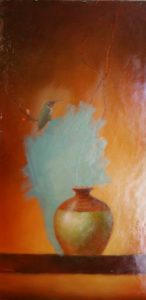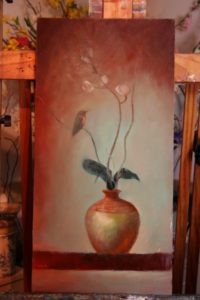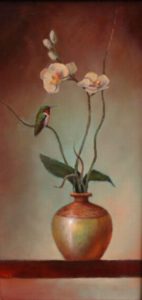Claude Monet once said to Paul Durand-Ruel, “I took your advice and managed to make some quite good things out of paintings I considered irredeemable.”
Do you ever have an older painting that just sits around in a gallery and never sells? The painting might go out ‘on approval’ or it’s been bounced around between your other galleries, but can’t seem to find a new home. This scenario happens to me from time to time however, I have learned how to re-work an old painting and make it sell.
First of all I want to say, sometimes a really great painting takes more than a year to sell and this happens to all of us. Often the painting might be in the wrong gallery or the market is too soft in your area, etc. But, sometimes the problem might be with the painting. And when this happens to me I get ruthless! I am known for ‘whiting out’ or gessoing over a ‘good painting’ because my gut tells me it just isn’t good enough.
It must be that thrifty Scottish blood that runs through my veins, but I don’t like to ‘waste’ a good canvas, board, paints or a frame on an unsold painting. I am a problem solver and if a basically good painting has not found an owner within a year, I like to take it home for an evaluation. Here’s what I do.
- Take the painting out of the frame
- Prop it up in my studio and study the composition and color
- How is the technique?
- How is the brushwork?
- Can it be improved?
If I can solve any of the above questions, then I get out my paints and start resuscitating that old painting. Some of you might ‘gasp’ at the thought of reworking a finished painting. It might seem like ‘cheating’ or you may even be scared of ruining the original. But, this process has been used by most of the art masters before us. Nothing is too precious, and what have you got to lose anyway? At the very least, this is a great learning process that will help you with your next fresh painting.
Just the other day, I revived an unsold still life painting and I am much happier with the new results.
The original painting, “Hummingbird & Green Vase” was an okay painting, but upon evaluation I knew it could be better. I decided that although the yellow/orange background was the natural compliment to the greenish/blue vase, the whole temperature of the painting was too ‘hot’. Also, I felt the painting was too austere.
- First, I sanded the hummingbird and twigs down a bit and used a thin layer of retouch varnish over the whole surface of the painting.
- Next, I chose to cool the background using just a dash of phthalo blue (very powerful pigment) mixed with Naples yellow and cadmium orange to neutralize the blue.
- I then decided to add more variation to the bare composition and drew in an orchid.
- I went back around the newly painted orchid with the cool background color to meld it all together and give the painting a feeling of atmosphere, but leaving a portion of the original background near the top.
- I reworked the hummingbird and gave him more vibrancy.
- Then at the last minute, I decided to open the orchids. Wow, what a difference! I am pleased with the results.
I even renamed the reworked painting, “Hummingbird & Orchids.” This is much stronger now than the original underpainting.
Let me know if you revive an old painting! Lori
P.S. It sold!
Below are some more articles you might like:
Helpful Ways to Negotiate and Set Your Art Prices
How NOT to Clean an Oil Painting
How to Stage Your First Art Exhibition
5 Savvy Tips for Selling Your Art
Create Texture & Application in Paint using Yin/Yang
Commissioned Art – Tips to make it a Success!
10 Tips to Bring Visitors to Your Art Fair Booth or Open Studio
7 Creative Ways to Approach an Art Gallery for Representation
Visual Artist’s Challenge II – Balancing Self Promotion & Gallery Representation
Commissioned Art – Tips to make it a Success!
Create a Powerful Portfolio
Have fun and I hope to meet you on Twitter and Facebook and Google Plus gplus.to/lorimcnee !!! ~Lori (If you want to see what I paint, please check out my paintings)












Your work is beautiful. The original painting in this blog post was very nice but I can see that the revised piece would be a better fit in most decors. Thanks for sharing the process. Really like your backgrounds. Was this piece done in oils?
I found this very interesting, and freeing. I want to tell you something. I was curious, so I called my 7 year old daughter over and showed her the “before” & “after” next to each other. I asked her which painting was better. She did pick the “after”. She said it was colder, that darker is colder, and apparently that was a good thing.
I was particularly interested in the increased dimension that you brought to the vase. Very nice.
I really liked the first painting too. Since it is so much work to retouch a painting I see more value in painting a second one instead. Then you have two! any thoughts?
Kendra – It has taken me a while to respond & I apologize! Anyway, sometimes I choose to rework an unsold painting that I feel could be improved upon. Actually, if I was happy with the unsold piece, I wouldn’t rework it – I would wait for it to find the right home. It is less effort to give a painting a ‘face-lift’ than to start another one from scratch. Thanks for your thoughts.
Nice! Bravo…I love the whimsy and interest that was added into the second piece…but indeed, I prefer the warmer tones of the background in the first.
I like to rework my paintings as well…have even made nude figures into clothed figures, figures into flowers etc… it is fun: but always keep record of the first image!
viva el arte!
Claudia
Hi Claudia and thanks for commenting. The first version of the painting seemed too austere to me, so I am happier with the second one – plus it sold right away! Many artists think it is scrilegious to paint over a painting that has been completed. I obviously disagree…if it hasn’t sold and I can improve on the painting, I will…thanks for visiting. Lori 🙂
Great post! I recently reworked a stone carving that I did ten years ago. It was never in a gallery; I’d just kept it, since it was one of the first stone carvings I’d done. I’m much happier with it now!
By the way, I liked your first painting above, but I must admit that I REALLY like the reworked painting. Congratulations on getting it sold!
Carol
Hi Lori..thankyou for your “demo” of your reworking process. Its something i do frequently. Sometimes after getting a painting back after a year or so, i find it really obvious what needs to be reworked. Often its just the last 5 – 10% of a painting that is the key to it selling, and sometimes for me the hardest bit.
Thanks Coral. I am glad to hear that there are other artists that do this to their paintings! Thanks for stopping by and sharing your comment.
Best – Lori
Good post! Very helpful. I can think of several of my orphans that might be redeemable!
Was your painting varnished? If so, did you have to remove it before reworking your painting? I can see the need to abrade the surface, but I’m wondering if you had any trouble re-varnishing already varnished areas of your painting.
My painting did not have a final varnish. If your painting has a final varnish, you will need to remove it to rework it properly. It is a bit of a chore, but worth the effort. Good luck!
Thank you……It’s really helpful..learned a lot…
Glad to inspire! Thank you 🙂